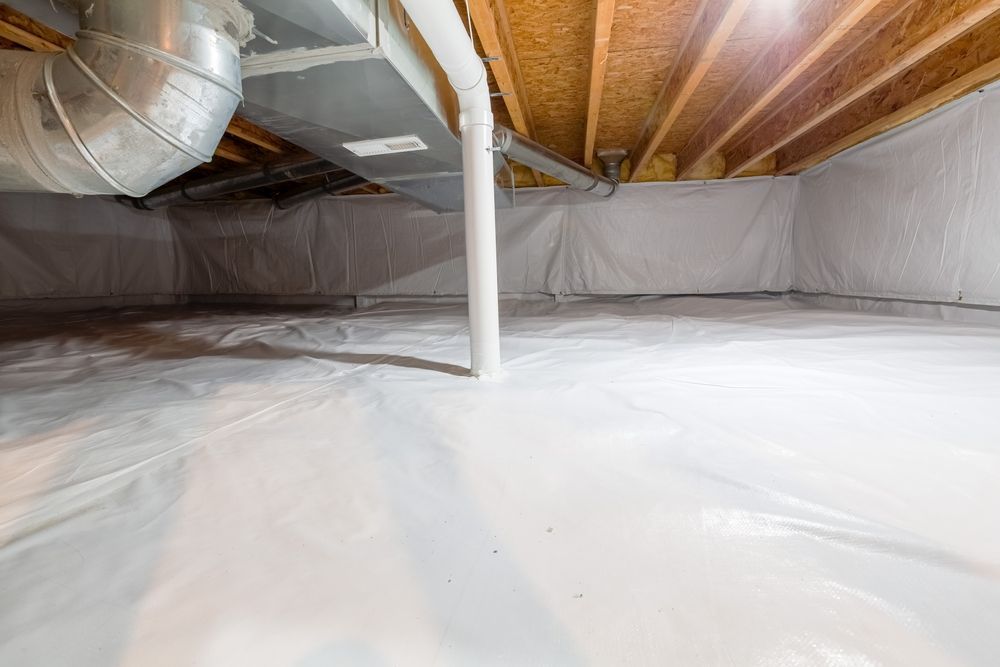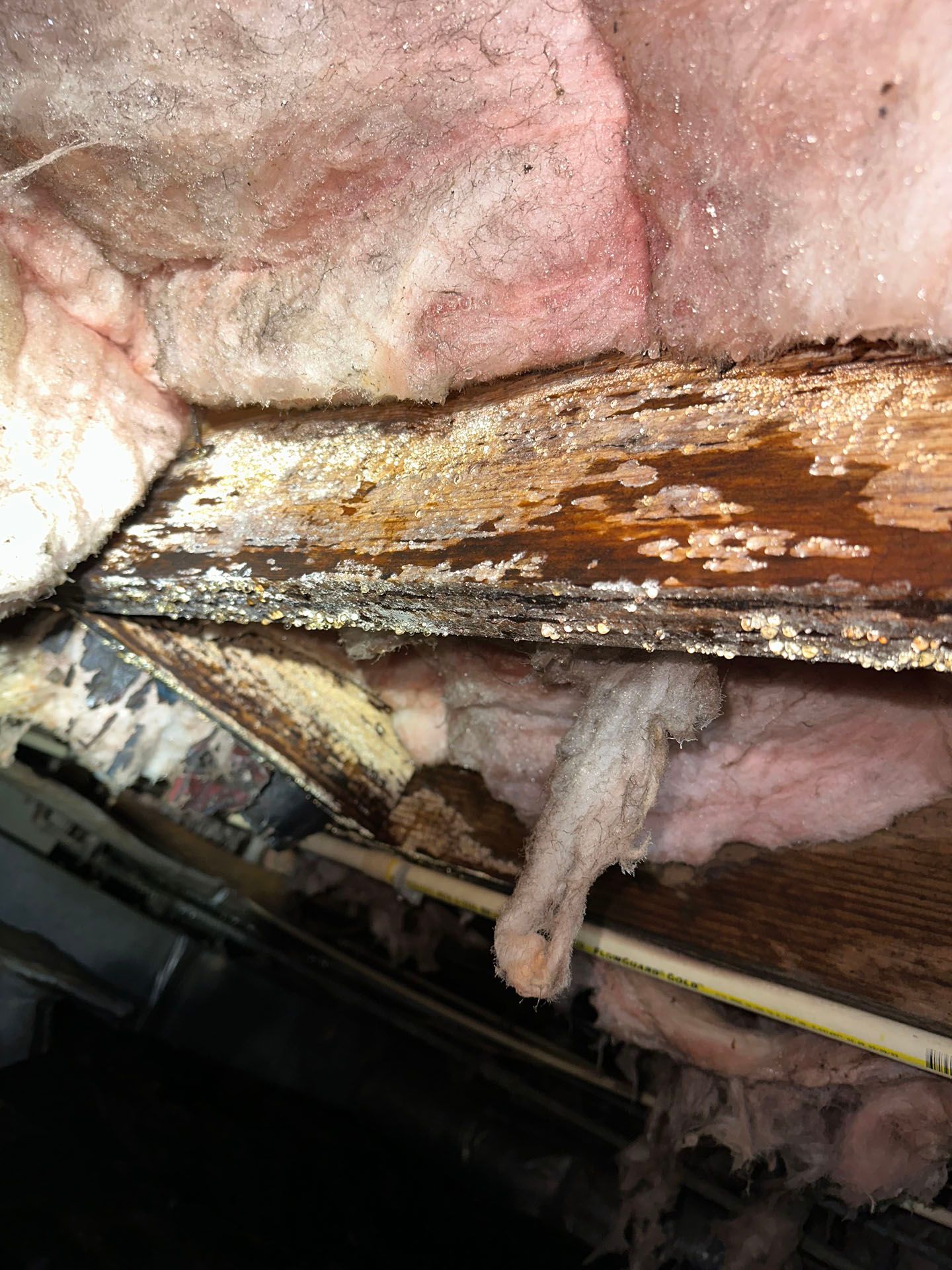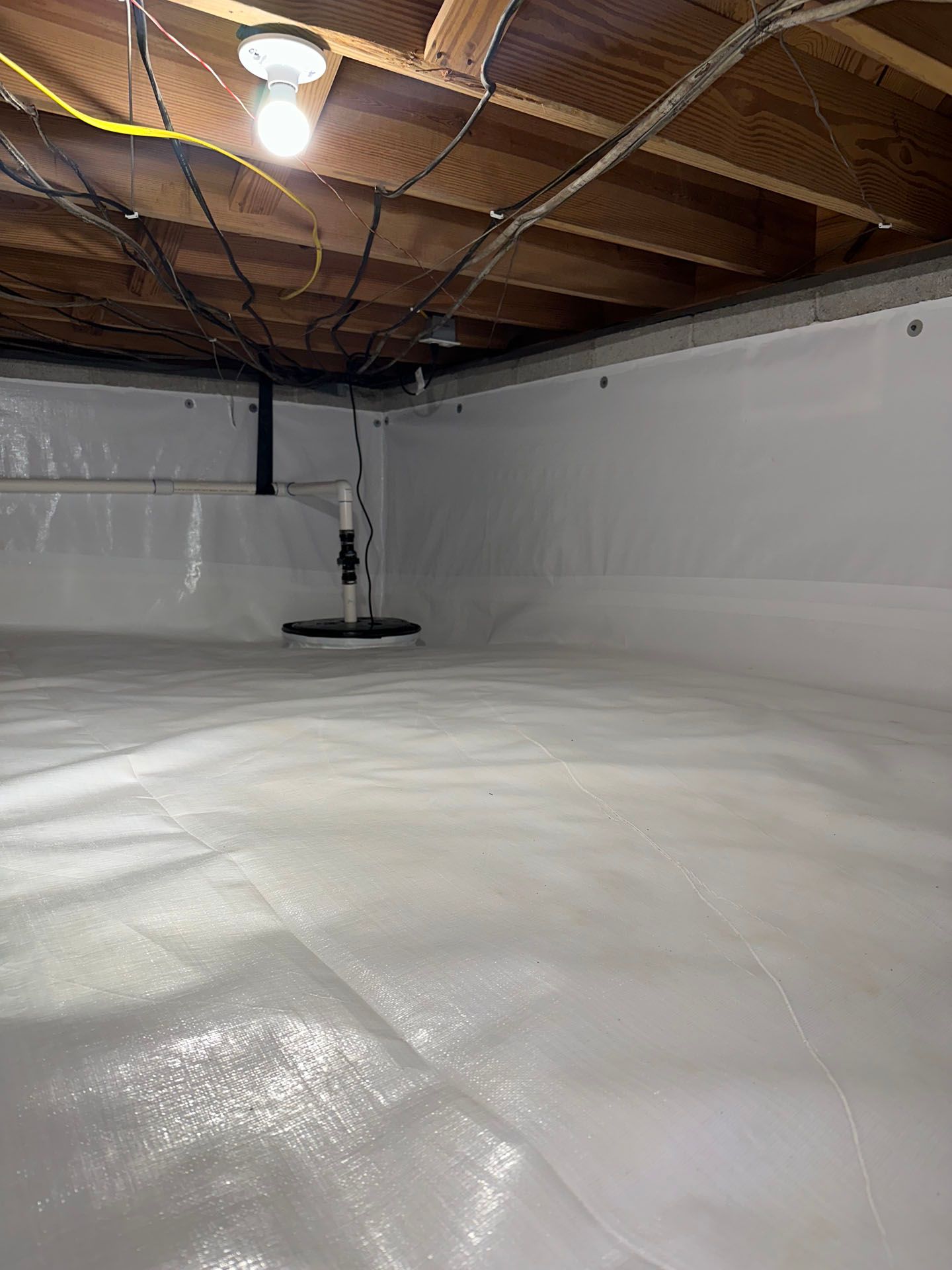Huntsville, Alabama

Claim Your FREE Crawl Space Inspection Today!
Sawyer Williams: 256-727-4422
Schedule Your Free estimate!
No-Obligation, Free Inspections
No-Obligation Free Estimates
We Warranty All of Our Work
100% Satisfaction Guaranteed
Chances are, you can’t even remember the last time you thought about your home’s crawl space, let alone ventured down there to take a look around. Unfortunately, you probably need to make the trip sooner than you’d like, because a neglected crawl space can lead to some serious health issues for you and your family. Today, we’re diving into the age-old question: can a crawl space make you sick? We’ll explore the common crawl space health risks, the preventative measures you should take, and how to get a creeping feeling that something may be amiss in your crawl space. Let’s dive right in!
Quick Clarification
Yes, a damp crawl space can make you sick. High levels of mold, pollen, and dust mites in a crawl space can cause health problems such as coughing, difficulty breathing, or aggravating existing asthma symptoms.
How Can a Crawl Space Make You Sick?
Crawl spaces can be the root cause of many health issues and illnesses, due to the damp environment they often provide. Poorly ventilated and sealed crawl spaces can act as a breeding ground for moisture, mold, mildew, dust mites, and other allergens which all have the potential to make someone sick if inhaled or ingested. However, there are also other environmental factors that need to be taken into account. Poor indoor air quality caused by high levels of humidity, inadequate ventilation, and the presence of volatile organic compounds (VOCs) can also make someone sick.
The debate over whether a crawl space is actually making a person ill or not largely lies in determining which environmental factor is causing the symptoms. While some may view an unclean and unsanitary crawl space as being directly responsible for illnesses, it’s important to note that most people who experience health issues linked to their poorly maintained crawl space may find relief when the specific problem is identified and corrected.
Looking out for signs of a problem in one’s crawl space is essential to protecting one's health. On the next section we will delve into what signs may signify an issue with a crawl space that should prompt further investigation.
Crucial Highlights
Crawl spaces can cause many health issues, due to the damp environment often present in them. Poorly ventilated and sealed crawl spaces can act as a breeding ground for allergens that can make a person sick. Poor indoor air quality caused by high levels of humidity, inadequate ventilation, and VOCs can also create health difficulties. It is important to look out for signs of a problem in one’s crawl space that could require further investigation.
Signs of a Problematic Crawl Space
It is important to be aware of the telltale signs that you may have a problematic crawl space. Poor ventilation, humidity, and water intrusion are all indicators that something has gone wrong in the area. If you notice an unpleasant smell, musty odors, or any other strange smells emanating from your crawl space, it is a sign of moisture buildup from water intrusion or poor ventilation. Visible signs of wood rot or mold growth are also indicators that something has gone wrong.
Debate the Both Sides of the Argument:
The debate about having a crawl space ranges from its potential benefits and detriments. On one hand, some argue that having a crawl space increases energy efficiency, provides more space for ductwork and pipes and makes future repairs easier than when there is no crawl space. On the other hand, some argue that these spaces can serve as a breeding ground for pests and mold growth. Developing foundation issues such as cracks, mold and mildew build-up due to moisture accumulation also could be attributed to a poorly maintained crawl space.
In conclusion, although a crawl space can benefit homeowners in certain cases, it needs to be carefully maintained in order to prevent health hazards and structural issues by regularly inspecting for visible signs of trouble such as mold, water damage or animal infestation. Without proper maintenance and inspection, it is possible for a homeowner to experience negative consequences from having a crawl space.
Lead into Next Section:
Moisture Problems in the Crawl Space are frequent issues faced by homeowners with poorly maintained crawls spaces. In the next section, we will discuss common sources of moisture in these areas and ways to mitigate related problems.
Moisture Problems in the Crawl Space
Moisture problems in the crawl space can quickly become a serious issue, leading to a host of potential health problems for those living in the home. Too much moisture and water in the crawl space can create an ideal environment for mold and mildew growth, which can cause allergies, respiratory problems, and other chronic illnesses. Even if a homeowner doesn't experience any health problems caused by moisture-related issues, they must still contend with the structural damage that can be caused by excess water.
Too much humidity and condensation in the crawl space is often caused by poor ventilation and inadequate insulation. Issues can also stem from air leaks due to open vent screens or improperly enclosed foundation openings. In extreme cases, insufficient drainage or plumbing failures have been known to lead to moisture problems as well.
On the plus side, having a vapor barrier installed can go a long way towards solving any existing or potential moisture issues in the crawl space of your home. This simple step can prevent further complications down the line by keeping excessive air moisture away from the damp soil below.
The next section of this article will address how to prevent water and moisture problems before they begin to take hold in your crawl space. It’s essential knowledge for any homeowner who wants to ensure their family’s safety and protect the integrity of their home for many years to come.
How to Prevent Water and Moisture Issues
When crawl spaces are left standing in water or high levels of moisture, mold and mildew can begin to grow unchecked, leading to a variety of health risks. To keep your crawl space dry and sanitary, preventive measures should be taken to stop water and moisture from intruding.
The first step is to ensure that the foundation has been sealed completely by caulking all around the exterior walls. Secondarily, check for any cracks or openings in the walls themselves and repair them with mortar or masonry sealant if necessary. Finally, consider installing a perimeter drain system outside the foundation’s walls to direct water away from the building.
Operating a dehumidifier in the crawl space can help lower the risk of mold growth as well by removing moisture from the air, as humidity will only propagate moisture-related issues. Additionally, fill any depressions with soil or sand so that water does not pool near the crawl space walls.
It’s also important to be cautious of how much rainwater your yard accumulates. This is especially true for those with properties surrounded by trees; leaves on the ground will trap more rainwater than turf grass or patios. The best method for managing this issue is to make sure that your gutters are always clear from debris since clogged gutters can cause flooding near your crawl space's walls and higher levels of humidity throughout your home.
To summarize, proper prevention is key when it comes to keeping a crawl space safe and healthy. By taking preventative steps such as sealing up cracks in foundations and walls, removing leaves from gutters and draining pooled water away from the exterior walls, you can reduce the chances of complications inside your home arising due to excessive moisture levels in the crawl space.
Now that we have discussed how to prevent water and moisture issues in crawl spaces, let's move onto discussing how to properly insulate and ventilate these areas next.
How to Properly Insulate and Ventilate the Crawl Space
When it comes to insulating and ventilating a crawl space, there are two camps of experts with different opinions. On the one hand, some believe that properly insulating and ventilating the space is an important step in creating a healthy indoor environment, while others argue that doing so may encourage mold growth and water damage. Ultimately, the best approach will depend on your particular circumstances.
If you decide to properly insulate and ventilate your crawl space, be sure to select a professional contractor who is knowledgeable about local building codes and regulations. This person can help you select the right type of insulation, such as rigid foam or spray foam insulation, which both provide superior energy efficiency compared to batts or blown-in cellulose insulation. It’s also important to install vapor barriers, as they can help prevent moisture from entering the area and promote a healthier environment inside. Finally, don’t forget to install ventilation fans. These objects provide fresh air circulation and can reduce moisture buildup.
On the other side of the debate are those who caution against proper insulation and ventilation of a crawl space since this can create the perfect breeding grounds for mold spores. They advocate using plastic sheeting on the floor instead, although this does nothing to protect against heat loss through conduction. Furthermore, it can create even worse conditions by trapping moisture up against walls and floors, leading to mold formation.
Ultimately, there is no one-size-fits-all approach when it comes to proper insulation and ventilation of crawl spaces. Homeowners should carefully evaluate their specific needs before making any decisions.
Once you have taken all necessary steps to properly insulate and ventilate your crawl space, it is time to consider potential contamination and air pollutant risks associated with having an unventilated or inadequate ventilation system in place. The next section will explore these risks in more detail.
Contamination and Air Pollutant Risks
A crawl space is a space between your home and the ground. It can be a potential source of contamination or air pollutants—environmental health hazards that are present in your home may become worse with the presence of a crawl space.
Mold, mildew, and other airborne particles can accumulate in a crawl space if proper ventilation is not employed. Poorly ventilated crawl spaces create an ideal environment for these particles to thrive because they provide an abundance of damp areas with poor air circulation. Mold spores and dust mites are known to carry allergens and other harsh chemicals, which can lead to breathing difficulties, eye irritation, allergies, asthma, and coughing.
On the other hand, if adequately sealed, ventilated and maintained well, then a crawl space can help prevent exposure to contaminants such as radon gas, which has been found to be associated with certain forms of cancer. A well-ventilated crawl space can reduce levels of radon gas by allowing fresh air to enter from outside and promoting the drainage of existing moisture from the soil below the house. This also helps reduce humidity levels in basement areas and prevents future growth of mold in those spaces.
Humidity levels in non-ventilated crawl spaces tend to remain high due to lack of airflow causing condensation buildup on walls or floor joists leading to further complications like wood rot and insect infestations.
Therefore, it is important to consider both sides when evaluating the contamination and air pollutant risks of having a crawl space in your home. One must consider all factors that may contribute to making poor air quality worse by allowing toxic gases, allergens, dust mites and humidity levels to go unchecked — but also appreciate that when managed properly a crawl space can be beneficial when combating radon gas levels and reducing moisture build up within basements or other living areas within your home.
Conclusion: Evaluating the Risks and Preventing Health Issues is critical in understanding how a crawl space can impact air quality, health risks, and living conditions within your home. In order to ensure these risks are minimized proper maintenance protocols should be considered so any negative impacts can be avoided.
Conclusion: Evaluating the Risks and Preventing Health Issues
The risk of getting sick from a crawl space is real and should not be taken lightly. Although it’s important to note that any form of water damage can create nasty molds and bacteria that can become airborne and thus lead to illness, the danger from undisturbed crawl spaces is heightened due to the likelihood of poor ventilation. When water damage does occur, it can quickly spiral out of control leading to costly repairs, health risks for occupants, and potential fines from local building codes.
For this reason, it is critical that both homeowners and landlords take proactive steps to ensure crawl spaces are safe. The most effective way to do this is to perform regular inspections of the space, even in cases where it appears dry and well maintained. This involves checking for signs of pests or rodents that may have moved in, as well as keeping an eye on any existing environmental factors like ventilation levels and moisture. By doing so, any changes in these conditions can be caught early on before they result in more serious problems.
In addition, water-resistant barriers should be installed around the walls of the crawl space to prevent moisture seeping in from the outside edges. Doing so will help keep out unwanted moisture build-ups that can then lead to mold growth and eventual sickness amongst residents.
It’s also important to use proper ventilation methods in a crawl space if water damage has already occurred or if there is noticeable moisture present. This includes using dehumidifiers and fans to ensure that moisture is removed from the area quickly and efficiently. Without proper ventilation measures, it’s only a matter of time before mold spores become airborne which could then lead to sickness among occupants.
Overall, evaluating the risks associated with having a moist or stagnant crawl space is essential as a means of preventing potential health issues down the line. With regular inspections and maintenance coupled with good ventilation methods in place, property owners will be able to avoid these potential dangers while simultaneously protecting inhabitants from adverse health repercussions.
- According to the EPA, damp and contaminated crawl spaces can lead to health problems such as allergies and asthma.
- A study published in 2011 concluded that elevated levels of dust mites and mold spores in homes with vented crawl spaces could cause respiratory illness and other health issues.
- Research conducted in 2003 showed that air from a crawl space had higher levels of formaldehyde, dustmites, and bacteria than air from other areas in the house.
Frequently Asked Questions and Responses
What are some signs that the crawl space may be making you sick?
Signs that your crawl space may be making you sick can include physical symptoms such as coughing, sneezing, headaches, and fatigue. These symptoms may be worse in areas closer to the crawl space or worsen during particular times of day when the moisture level of the basement is highest. Respiratory issues or asthma attacks may be exacerbated by a damp, dirty crawl space. Other signs can include an overall musty smell coming from the basement or seeing signs of mold or mildew growth in the basement. If there is flooding or water damage present in the basement, this can indicate humidity levels are too high and should be addressed immediately.
What health problems can arise from living in a home with an inadequately maintained crawl space?
Living in a home with an inadequately maintained crawl space can be detrimental to your health. Dust, mites, mold and mildew can accumulate within the walls and cause allergies and asthma. Poor ventilation within the crawl space can lead to high humidity, which can encourage mold growth. Bacteria and viruses also thrive in these damp areas, potentially leading to respiratory issues. Radon gas, a colorless and odorless gas that can occur naturally, can also be present due to poor circulation within the area. If not properly ventilated, radon gas can reach dangerous levels and cause severe lung problems. Pests such as rodents or termites can further contaminate the air quality by leaving behind feces and urine filled with harmful molecules. It is important to ensure that air enters and exits the crawl space in order to prevent such health issues.
How can you prevent health risks associated with having a crawl space?
The best way to prevent health risks associated with having a crawl space is to ensure the area is properly sealed off from moisture entering the space, as well as from mold and bacteria growth. Make sure that any cracks in the walls, joints, or other entry points for air are adequately sealed. Additionally, investing in a dehumidifier or running a fan can help keep air circulated and moisture-free. Use of vapor barriers on the walls and floor of the crawl space will also prevent moisture buildup and potential mold growth. Lastly, ensure that any insulation installed within the crawl space utilizes an antifungal agent to inhibit mold growth. With these simple steps taken, you can be sure your crawl space environment is safe and secure.

Written by Sawyer Williams
Precision Crawlspace & Renovations
Sawyer has specialized in crawl space and foundation repairs for over six years. As the founder of Precision Crawlspace and Renovations, he is one of Huntsville's top experts in crawlspace moisture control. He has prior experience installing these systems, which has prepared him to solve complex problems related to crawl space encapsulation, mold remediation, and waterproofing.
Recent Blog Posts
Huntsville's Crawl Space News



What are you waiting for?
We Solve Crawl Space Issues!
Get reliable crawl space repair services at an affordable price, provided with the high level of service you deserve.
Call Us Today at: 256-727-4422
All Rights Reserved | Precision Crawlspace & Renovations

